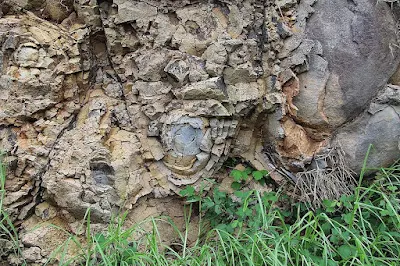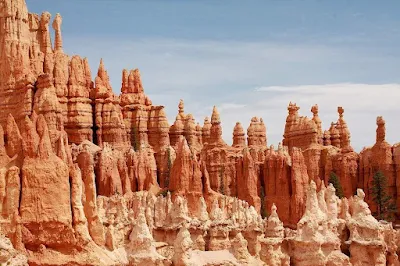What is Weathering, Types of Weathering
What is Weathering
Weathering is the process of breaking down rocks, minerals, and other materials at or near the Earth's surface. It is caused by a variety of physical, chemical, and biological agents, and it plays an important role in shaping the landscape and creating soil. It is the initial step in the cycle of erosion, leading to the formation of sediments and eventually, the creation of new rocks.
Factors that Affect Weathering
The rate of weathering is influenced by a number of factors, including:
- Climate: Weathering is generally more rapid in warm, humid climates than in cold, dry climates.
- Rock type: Some rocks are more resistant to weathering than others. For example, granite is more resistant to weathering than limestone.
- Surface area: Rocks with a large surface area are more susceptible to weathering than rocks with a small surface area.
- Time: Weathering is a slow process, but it can have a significant impact on the landscape over time.
 |
| Tafoni and pebbles at Pebble Beach, San Mateo County, California. Photo: Dawn Endico |
Weathering Types
There are three main types of weathering: physical, chemical, and biological.
Mechanical (Physical) Weathering
Physical weathering is the process of breaking down rocks and minerals into smaller pieces without changing their chemical composition. This can be caused by a number of factors, including:
 |
| Physical Weathering of volcanic rock |
Physical Weathering Types & Examples
Thermal expansion and contraction: When rocks are heated up, they expand. When they cool down, they contract. This expansion and contraction can create cracks in the rock that allow water and other agents to enter and further break down the rock. Repeated cycles of heating and cooling can cause rocks to crack and break apart.
Exfoliation weathering, also known as sheeting or unloading, is a type of mechanical weathering where large, curved sheets or slabs of rock progressively detach and break away from the outer surface of a rock mass. This process occurs due to the release of pressure on the rock, often following the removal of overlying material by erosion, tectonic uplift, or glacial retreat. As pressure lessens, the outer layers of the rock expand, causing them to crack and peel away in a characteristic onion-like fashion.
Frost wedging: Water seeps into cracks in rocks. When the water freezes, it expands, putting pressure on the rock and widening the cracks. Repeated freezing and thawing cycles cause the cracks to grow, eventually breaking the rock apart. Common in: Areas with frequent freeze-thaw cycles, like mountainous regions and high latitudes.
Abrasion: Rocks are worn down by the physical impact and grinding action of other rock fragments carried by wind, water, or ice. Common in: Riverbeds, coastlines, and deserts (wind abrasion).
Salt Crystallization: Saltwater seeps into cracks and pores in rocks. When the water evaporates, salt crystals are left behind. As these crystals grow, they exert pressure on the surrounding rock, causing it to weaken and break down. Common in: Coastal areas, arid regions, and areas with salt-rich groundwater.
Chemical Weathering
Chemical weathering involves the alteration of the chemical composition of rocks and minerals. It occurs when rocks and minerals interact with substances in the environment, such as water, acids, and oxygen. These reactions convert some of the original primary minerals in the rock to secondary minerals, remove other substances as solutes, and leave the most stable minerals as a chemically unchanged resistate.
 |
| Honeycomb weathering at Altdahn Castle in the Palatinate Forest, Germany |
Chemical Weathering Examples
Dissolution: Water and acids can dissolve certain minerals in rocks, leading to their breakdown. For example, acidic rainwater can dissolve limestone, forming caves and sinkholes.
Oxidation: Oxidation occurs when minerals react with oxygen in the atmosphere, forming oxides. When minerals containing iron are exposed to air and water, they can rust, forming new compounds that are weaker and more susceptible to further weathering. This process is common in iron-rich minerals, causing them to rust and turn red or brown.
Hydrolysis: Hydrolysis occurs when water molecules react with the mineral's chemical structure, breaking down their chemical bonds and forming new compounds. This process is particularly effective on minerals containing silicon, such as feldspars.
Biological Weathering
Biological weathering involves the breakdown of rocks and minerals by living organisms. This can be caused by a variety of factors, including plants, animals, and microorganisms.
 |
| Biological weathering of basalt by lichen, La Palma |
Biological Weathering Examples
Root Penetration: Plant roots can exert pressure on rocks as they grow, gradually breaking them apart. Additionally, the release of organic acids from plant roots can contribute to chemical weathering.
Burrowing Animals: Burrowing animals, such as earthworms and moles, can dislodge rock fragments and mix them with soil, contributing to the breakdown of rocks.
Microorganisms: Microorganisms, such as bacteria and fungi, can secrete acids that dissolve minerals, contributing to chemical weathering. They can also break down organic matter, producing humic acids that further enhance chemical weathering.
Landforms Created by Weathering
Weathering can create a variety of landforms, including:
Inselbergs: These are isolated hills or mountains that are found in plain areas and deserts. They are the result of weathering and erosion, and they are often made of hard, resistant rocks that are more resistant to weathering than the surrounding rocks.
Mushroom rocks: These are tall, isolated hills whose shape resembles a mushroom. They are the result of weathering and erosion, and they are often made of soft, easily weathered rocks that are more susceptible to weathering than the surrounding rocks.
Pinnacles: Pinnacles are tall, pointed rocks that are formed when the surrounding rocks are eroded away. Weathering can help to isolate pinnacles by breaking down the rocks around them.
Hoodoos: Hoodoos are a type of weathering landform that is formed by the erosion of soft rock formations, such as sandstone. They are often found in areas where there is a lot of wind, such as the deserts of the southwestern United States.
Spheroids: These are round, egg-shaped rocks that are found in deserts. They are the result of physical weathering, and they are often caused by the exfoliation of rocks due to changes in temperature.
Karst topography: Karst topography is a type of topography that is characterized by sinkholes, caves, and other landforms that have been created by the dissolution of limestone. Karst topography is often found in tropical and subtropical regions. Limestone is a rock that is composed primarily of calcium carbonate. Calcium carbonate is soluble in water, so when limestone is exposed to water, it dissolves. This process creates sinkholes, caves, and other karst landforms.
Tafoni: Tafoni are large, cavernous holes in rocks that are caused by a combination of chemical and mechanical weathering. They are typically found in arid or semi-arid climates, where there is little rainfall to wash away weathered material.
Honeycombs: These are hexagonal-shaped weathering patterns that are found on rocks. Honeycombs is formed by the dissolution of limestone by acidic rainwater.
 |
| Mushroom Rock formation (Saudi Arabia) |
Weathering Effects and Importance
Weathering has a number of important effects, including:
- Soil formation: Weathered rock fragments and mineral particles form the basis of soil, providing the essential ingredients for plant growth and agricultural activities.
- Landform development: Weathering can create unique landforms, such as caves, arches, mountains, valleys, and canyons. by selectively eroding different rock types and structures.
- Mineral resource formation: Weathering can concentrate minerals, making them more accessible for mining.
- Archaeological preservation: Weathered artifacts can provide valuable clues about the past.
 |
| Mushroom Rocks State Park, Dakota Sandstone Formations, Kansas (Credit: John Coletti) |
Weathering is a continuous process that is constantly shaping the Earth's surface. It is a complex process that involves a variety of factors, including physical, chemical, and biological processes. Weathering is an essential part of the Earth's systems and plays an important role in soil formation, nutrient cycling, and landscape formation.
 |
| Bryce Canyon Hoodoos, Utah Photo: Bryan Pocius |
Weathering is a fundamental process that shapes our landscapes, creates soil, and plays a crucial role in the rock cycle. It's a continuous interaction between the Earth's lithosphere, atmosphere, hydrosphere, and biosphere.
See also:
Exfoliation Weathering: Causes, Examples
Carpet Rock - Types, and How Did Carpet Rock Form
Grain Size - What is Grain Size and How is It Measured?
Identifying Transgression and Regression in Sedimentary Outcrops


%20(1).webp)






